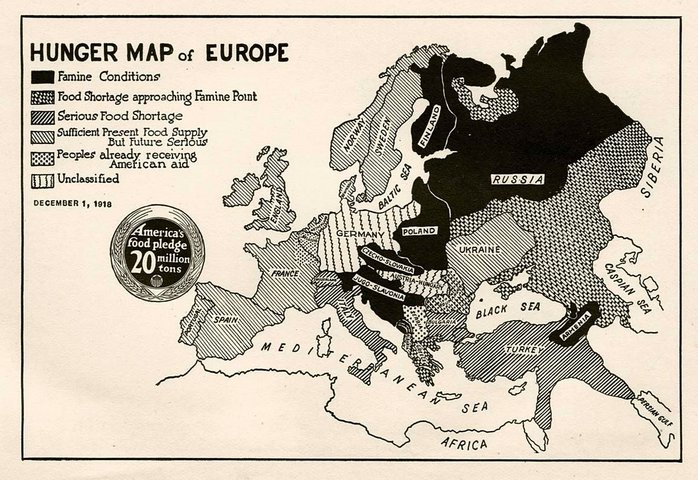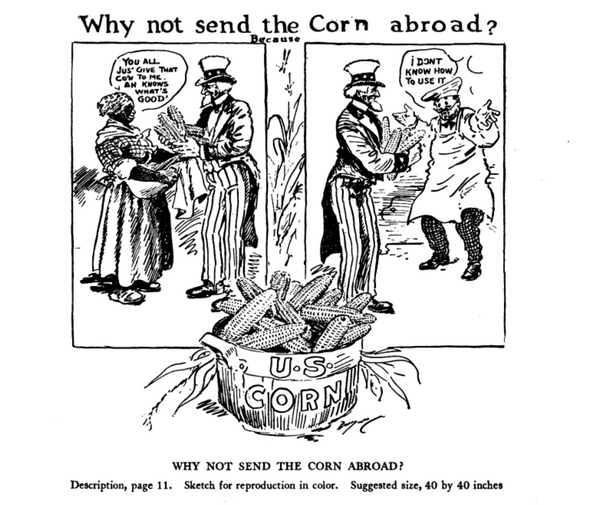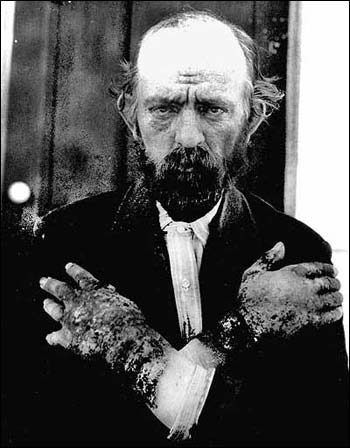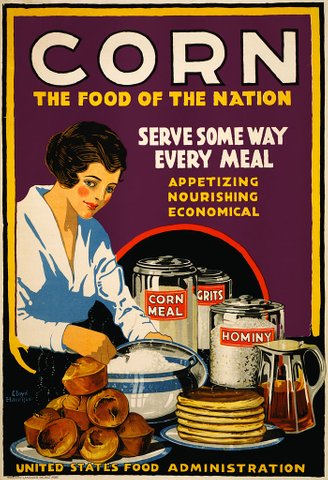Wartime Rationing, Food Aid, and "Civilized" Sickness: The Problem of Pellagra in 1918
I most recently wrote about wartime food restrictions under the #explore1918 theme in Everybody's Got to Eat! Cooking like it's 1918. Today I address a more serious side of the issue: the effect of nutritional deficiencies that could result from prolonged dependence on the type of wheatless and meatless diet that the U.S. Food Administration endorsed during World War I. Sometimes an essay topic just occurs to a writer, and other times it draws on years of stockpiled bits of research that add up to a whole. This article is the result of the latter process.
After the war, came the hunger
When four years of battle had destroyed Europe's fields and crops, the Great War's starving survivors badly needed food aid, and Americans stepped up. But what crops could they send or cultivate overseas? The obvious answer to many Americans was the plentiful resource of corn, although Europeans were hesitant to accept it. Philadelphia's Franklin Institute invited David Fairchild ("Agricultural Explorer in Charge, Office of Foreign Seed and Plant Introduction, U.S. Department of Agriculture") to speculate why. His answer? Pickiness. This assumption was way off.

Lazy? Picky? Snobby? Why wouldn't Europeans eat corn?
Fairchild's lecture on the topic, entitled "The Palate of Civilized Man and its Influence on Agriculture," was published in the Journal of the Franklin Institute in March 1918. Reporting that even in the face of starvation, European peoples looked upon cornmeal as "chicken food," he struggles to explain it, but can only conclude that they are fussy and traumatized, and cannot get used to eating new foods. Still, though, he reflects: "When I first heard that the Belgians refused to eat corn, and that the Irish and English would eat anything else before they would touch it, my first impulse was to insist that they ought to be made to eat it." [1]

The problem of pellagra
 American man suffering from pellagra. Source
American man suffering from pellagra. SourceOver the course of the 18th and 19th centuries, Spanish and French scientists had investigated the cause of pellagra and determined its connection to corn, although they could not explain the exact issue. Theories varied, attributing the disease to mold or other possible toxins in corn, perhaps involving hereditary issues among the poor. Dr. Théophile Roussel, a French physician, performed lots of studies on the disease. He then presented his findings to the French government, which took steps to decrease cultivation of corn in the country, replacing it with wheat and other cereal grains that did not correlate with pellagra. As a result, pellagra rates in the country plummeted. [4] Corn was relegated to the status of chicken feed because it was not considered fit for human consumption in Europe. In the United States, on the other hand...

When "civilization" leads to sickness
So what is corn's connection to pellagra? The issue is chemical and has to do with the way that corn is prepared for eating. At heart, pellagra is largely a result of a body's deficiency in the vital nutrients niacin (Vitamin B3) and/or tryptophan. Milling corn into meal rather than eating the kernels reduces its dietary value, and if that is a lynchpin of someone's diet, that dietary value may not be supplemented with other foods. Ironically, the American Indians who originally cultivated the crop do not suffer from pellagra because their way of preparing corn (mixing it with an alkali like woodash lye or limewater prior to eating it, a process called "nixtamalization") restores the food's niacin content. This "uncivilized" manner of making cornmeal was not adopted by colonizers in the Americas because it didn't suit the European palate.
David Fairchild assumed that Europeans' aversion to corn was irrational and ungrateful, but he came to this conclusion by ignoring the pellagra epidemic taking place in his own country. That a scientist could seriously argue this point in a lecture before a prestigious American institution indicates several things about life in 1918. Firstly, it shows the nascent stage of nutritional science at that point- for which Fairchild is not accountable, obviously. But more strikingly, it reveals the limitations of the field of scientific inquiry, where assumptions about race and class can override objective scientific analysis, even when unintentional. I wonder: How much has that changed since then?
100% of the SBD rewards from this #explore1918 post will support the Philadelphia History Initiative @phillyhistory. This crypto-experiment conducted by graduate courses at Temple University's Center for Public History and MLA Program, is exploring history and empowering education. Click here to learn more.
Works Cited
- David Fairchild, "The Palate of Civilized Man and its Influence on Agriculture," The Journal of the Franklin Institute 185, no. 3 (March 1918).
- Alan Kraut, "Dr. Joseph Goldberger and the War on Pellagra," National Institutes of Health. Online exhibit. https://history.nih.gov/exhibits/goldberger/index.html.
- George M. Niles, Pellagra: An American Problem, Philadelphia: W.B. Saunders Co., 1912. https://books.google.com/books?id=gC8pAAAAYAAJ.
- Richard D. Semba, "Théophile Roussel and the elimination of Pellagra from 19th century France," Nutrition 16, Issue 3 (2000), 231-233, http://www.sciencedirect.com/science/article/pii/S0899900799002737.
This is so interesting! I've never heard of pellagra before, but this reminds me of a story a former German professor told my class. Interestingly he corroborated Fairchild's "pickiness" argument, saying that the Germans/Austrians equated corn to pig food. Your answer makes much more sense and is certainly richer. Thanks for sharing!
I never really thought much about the difference in grain consumption until I found out that the "Vollkorn" I was seeing everywhere actually meant like whole grain, and that "Korn" basically just appeared in context with "Hühner," as opposed to "Mais," which I never saw actually used in any context. It's weird.
Wow. I had no idea. History of science and the ways scientists have molded their "findings" to fit corporate and national interests is an important area that hopefully grows in the future.
Yeah, I mean scientists are just people, prone to human error and prejudice. This reminds me of a Radiolab episode I heard recently which you might find interesting: http://www.radiolab.org/story/stereothreat/
Rich story! Can you share with your readers how you came up with it?
I added a short bit at the top! I've been wanting to write about pellagra for a long time, and the Journal of the Franklin Institute article just gave me a good entry point. I think it's a good counterpoint to the treatment of tuberculosis that became less associated with socioeconomic status over the course of the Progressive Era. Pellagra is easier to treat but retained its stigma into the 1930s.